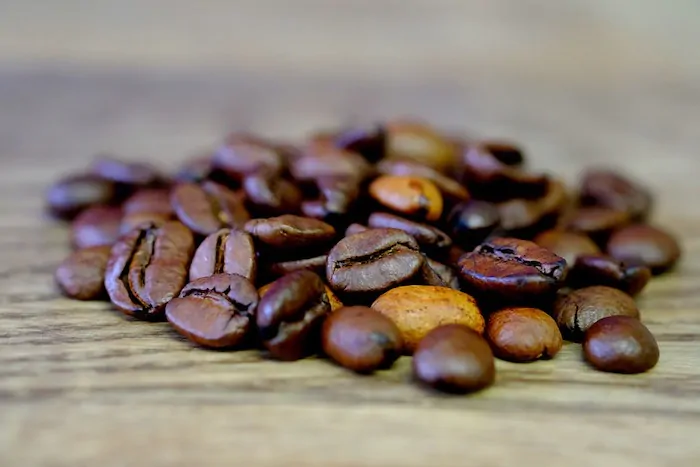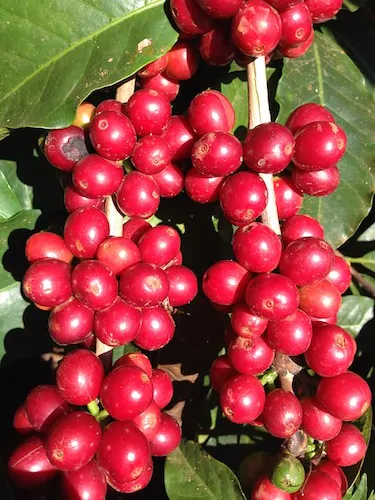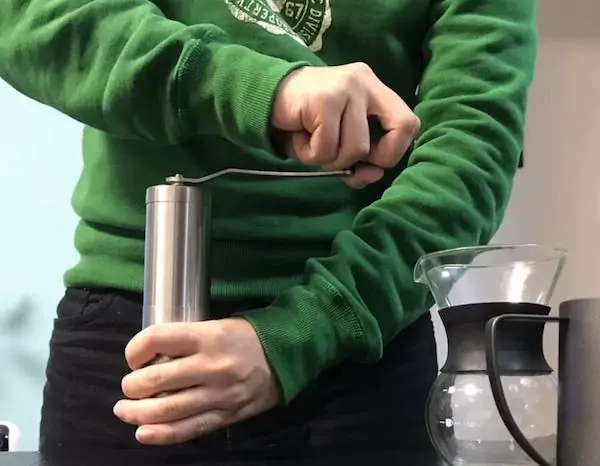Wondering ‘can you make coffee with whole beans’. Read this article to find out how to make good coffee without grinding the whole coffee beans.

For many people around the world, including me, coffee is that amazing incentive to get out of the cozy bed even on cold winter mornings. There are numerous ways to make a steaming hot cup of Joe, but most of them involve grinding the roasted coffee beans in a quality grinder.
Today, I want to address a frequently asked question – ‘can you make coffee with whole beans’ the answer is yes, you may. However, please be warned that brewing coffee with whole beans without grinding them will not result in that characteristic aroma and flavor that you are familiar with.
Even if you use the same amount of whole coffee beans as the grounds, it will result in slight brownish water with a pale hint of coffee and there is a scientific reason behind this. When you use whole beans for brewing, a relatively low surface area of the pod gets exposed to hot water for extraction.
As a result, I recommend grinding the whole coffee beans (see my favorite grinder) into smaller particles of desired consistency to get the best results. The grinding process breaks down the whole coffee beans into tiny particles, the surface area increases exponentially.
This helps in releasing the maximum flavors and achieving the ideal level of extraction from coffee beans within a reasonable time. Too fine dust-like fine consistency may result in over-extraction and turn your brew bitter while too coarse particles may result in under extraction, thus a sour coffee.
If you still wish to use coffee with whole beans without grinding it, this is possible and you will need to follow the steps below. Read on also to find out why grinding whole beans at home is better than buying ground coffee from a supermarket.
Steps For Brewing Coffee With Whole Beans
While we know most people will prefer to use ground coffee beans to make their favorite cuppa quickly, there may be situations when you are stuck without a grinder. So, if the old grinder has broken down or you get a coffee craving in the middle of a forest, here are steps to brew coffee using whole beans:
Take a mason jar like this and fill it with whole beans to a 3 oz level. Check the markings on the jar to ensure accurate measurement.
Add a cup of hot water to the jar and you can see that the beans start floating slightly over the water level.
Now, keep the mason jar in a sauce container and pour hot water to the same level as the level inside the mason jar.
Place the container over the stove and allow it to simmer for at least one hour. Adjust the temperature by increasing or decreasing it as required.
After one hour, you may take the mason jar out of the container. Remember to use tongs or towels to avoid burning your fingers. Pour out the liquid and leave the coffee beans behind.
Enjoy your freshly brewed cuppa.
Things To Know Before Buying Whole Coffee Beans
When you are in the market to buy coffee, you will be presented with two primary options – ground coffee to make an instant beverage and whole coffee that you need to grind in order to extract your flavourful cup of Joe.
The reason why I always prefer and recommend the second option is that coffee beans start leaking flavor and aroma as soon as they are grounded. In the powdered form, the surface area increases and so the particles become more reactive to the oxygen and moisture content in the air.
Make sure you only grind as many whole beans as needed to make a cup of coffee so that you do not waste any aroma. So, now that you know that you must get the whole coffee beans, there are two main categories you will need to choose from – single origin and blends.
Single-origin coffee: These whole coffee beans are mainly sourced from one specific location. They usually have strong and distinguishing characteristics that are specific to the location to which they belong.
Most of the single-origin coffee beans are sourced from Africa, Tanzania, Arabia, Brazil, Central, and South America. The African and Arabian coffee beans exhibit winey, exotic, and fruity flavors; American beans have bright yet mild flavors; and Pacific coffee beans have smooth, savory, and earthy flavors.
Coffee blends: These beans comprise exotic flavors released from single-origin beans as the base, and this is mixed with a wide range of flavor combinations. The intensity levels also vary widely, so you can expect to find rich, milky, bold, delicate-bodied, and slightly bitter flavors.
Related Article: Roasted Coffee Vs Instant Coffee
Understanding Whole Coffee Beans Roast And Types

The coffee beans that come from the red cherry are not used as it is. The outer fleshy part is discarded and only the beans are collected. The coffee beans then go through the process of roasting and it is the roast quality that affects the intensity and flavor of your beverage.
Before they are roasted, the beans are soft textured and green in color. They smell almost like fresh grass and the roasting process transforms it from raw beans to brown-colored aromatic coffee beans used to brew your favorite cup of mud.
If you have bought roasted coffee beans from the market, you may have noticed that they are not colored uniformly. Some of them have a light brown hue while others have a darker accent. Have you ever wondered what makes them different in hues?
The level and intensity of roast make them vary and today we will discuss the three main roast types you can expect to find in the market. Let’s take a look at their physical characteristics and chemical compositions.
Light Roasts: These beans are called so because of their light brown color and they don’t have any oil on the surface, plus they exhibit a very light body. They are mostly known for their acidity characteristics and toasted-grain flavor. The caffeine level in these roasts is typically high because the light roasts retain most of the caffeine found in the beans.
Medium Roasts: These beans have a medium brown color, hence they are named so. They don’t have any traces of oil on the surface but the beans have a much more balanced flavor, aroma, and acidity than the lighter counterparts. The medium roasts also contain less amount of caffeine than the lighter version.
Dark Roasts: As the color of the beans deepens, their level of caffeine decreases hence there is less amount of caffeine in the darker roasts. There is a light sheen of oil on the outer side of these dark-brown to almost-black beans. Dark-roasted beans work best for making espresso.
For more: How To Roast Coffee Beans At Home
Difference Between Whole Beans And Ground Coffee
Whole coffee beans and ground coffee are a much-debated topic among the coffee fanatics, with both sides having their own story. While there is a good number of people who use ground coffee for its great accessibility, ease of use, and no-mess aspect, connoisseurs believe that such people are unknown to the real aroma and flavor of the coffee.
Despite this, many people still continue to use the instant mix of ground coffee easily available on the shelves of any local supermarket. In powder form, it is not only ready to brew but does not require any additional skill or equipment other than hot water and sugar.

There is a percentage of coffee lovers who choose grounded coffee because they don’t know what to do with whole coffee beans, or they don’t have the right equipment. While this may appear as an easy solution, the biggest downside of using grounded coffee is that it is less fresh than the one you grind.
In grounded coffee, the oxidation process has already started and you will never be able to relish the authentic taste. The bean oils that contain a concentration of all flavors and aromas are evaporated by the time it reaches you. Even if the instant mixes come in vacuum-packed cans, they will be less fresh than the coffee you grind yourself.
If you want to taste the best coffee, invest in a good quality grinder that can make you a great cup of coffee at any time. Grinding methods may differ depending on the style of coffee you wish to enjoy. For example, a coarse grind works best for French Press while a fine grind is used in espresso.

A good coffee grinder from a reputable brand should let you grind the beans to your desired consistency. It should also allow you to change the fineness any time you want to. The biggest downside to using whole beans is the extra time and effort you need to put into grinding the beans.
Another disadvantage of using a coffee grinder is that it’s too much of a chore for some people. Not everyone may want one more kitchen equipment to claim counter space and clean after use. So, depending on your personal preference and requirements, you may choose to buy a small and cheap grinder or a more expensive one with many features.
The burr grinders are considered the best as they are capable of grinding the coffee beans more accurately to the desired size. The blade grinders are cheaper but they simply chop the beans instead of properly grinding them.
Related Questions
What’s the best way to store whole coffee beans?
You can make coffee with whole beans but they tend to lose flavor if exposed to moisture, heat, air, or light. To preserve the aroma and flavor of coffee beans, you must ensure that you store them at room temperature in airtight containers. If your countertop gets a lot of sunlight, store the beans inside the cabinet.
How long do whole beans last?
As soon as the beans are roasted, their flavor starts depleting so I recommend that you buy them in small quantities to avoid losing their aroma and flavor. Try to buy them every one to two weeks to ensure that your whole beans always stay fresh.
Why is it better to grind your own whole beans?
By grinding your own coffee beans, you can ensure that you retain the optimum aroma and flavor. Also, you will be able to grind the perfect consistency and coarseness based on the type of coffee you wish to brew.
